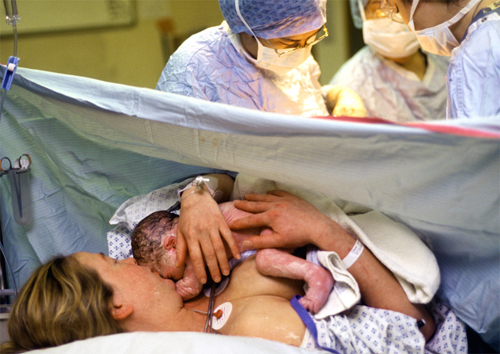Cesarean Section
A cesarean delivery may be suggested if there is a potential benefit to your own or your baby’s health, or sometimes both.
A cesarean section is the
delivery of your baby by means of a cut in the abdomen. A cesarean rate
of around 10–15 percent is thought to be reasonable, although in most
Western countries the rate has risen beyond 20 percent and around 30
percent of all babies in the US are now delivered by cesarean, an
all-time high.
The increase is due to a
higher incidence of cesareans in first-time mothers and a lower
incidence of vaginal birth after cesarean (VBAC) in subsequent
pregnancies. Some women may think that cesareans are safer for the baby
than a vaginal birth. In fact, if you’ve had an uncomplicated pregnancy,
a cesarean is hard to justify on medical grounds.
Types of cesarean
Cesareans are either
emergency or planned procedures. The doctor will assess its urgency with
a grading scale. A Grade 1 cesarean is one that is done if there is an
immediate threat to the baby’s or mother’s life. A Grade 2 cesarean is
one where there is concern for the baby’s or mother’s well-being, but no
immediate threat to life. A Grade 3 cesarean is done when there is no
immediate concern for the mother or the baby, but an early delivery is
advised, perhaps because of a condition in the mother or baby. A Grade 4
cesarean is an elective delivery planned to suit the woman and the
hospital.
Emergency cesareans
A Grade 1 cesarean
is most commonly carried out when the baby is thought to be at risk, for
example if the baby’s oxygen supply has been reduced and there are
signs of fetal distress. In this case, the staff will try to do the
cesarean rapidly—within 30 minutes when possible, although it’s
important that shortcuts aren’t taken that could put your own health at
unnecessary risk.
Grade 2 and
Grade 3 cesareans take place when there’s no immediate threat to life,
and these are more common than Grade 1 procedures. A Grade 2 cesarean
may be done if your baby’s heart rate is causing concern very early in
labor and the prospect of a vaginal delivery taking place within a
reasonably short time is low. An example of a Grade 3 cesarean is one
that is done because of a failed induction of labor.
Elective cesareans
Around one third of
cesareans are elective, or Grade 4 procedures, and the number of these
has increased greatly in recent years. Reasons for an elective cesarean
include a breech baby; a tear involving the back passage, or another
traumatic event, during a previous vaginal delivery; a previous
cesarean; a larger than average baby; and maternal choice. In these
situations, although a cesarean is reasonable, an attempt at a vaginal
birth is also reasonable with the right precautions. It’s uncommon for
maternal choice to be the sole reason for a cesarean, and there’s likely
to be another factor, such as one of those cited above.
In some situations, it
would be hazardous for either you or your baby if you were to try for a
vaginal birth; for example you’ve had multiple previous cesareans or
other major surgery to the uterus; the baby can’t be moved from lying
horizontally; the placenta is lying very low ;
or there are severe pelvic abnormalities in the birth canal. Some
maternal medical conditions also mean that vaginal birth is not
advisable.
Giving your consent
The doctor will need your
consent prior to doing a cesarean. He should tell you why the procedure
is being proposed, and what its benefits and risks are. Ideally, you
should have plenty of time to decide whether you want the surgery or
not, although with an emergency cesarean, the time to think things over
may be limited. Even so, you are always within your rights to say no to a
cesarean, even if this means that your life or that of your baby is at
risk.
Your anesthesia
Before the surgery, you
will meet an anesthesiologist, who will make sure that you have no pain
during your surgery and will help you with pain control afterward. Most
women are awake during a cesarean. An injection of medication into the
spinal fluid in your back, called a spinal block, numbs any sensation of
pain . Or, if you’ve been using an epidural for pain relief in labor ,
this can be used for the surgery. After your anesthetic has been given,
the anesthesiologist will check that it is working properly.
Being awake usually
means that your birthing partner can stay with you and it’s also a
little safer for you and for your baby than a general anesthetic. Very
occasionally a general anesthetic is needed .
The surgery
Before the surgery, an
IV line will be put in your hand or your arm so that fluids or
medications can be given intravenously if necessary. Also, the pubic
hair on your belly may be shaved downward by about 1 in (3 cm) to clear
the way for the cut. Both of these may be done before you go to the
operation room or after you arrive there.
Once the anesthesiologist
is assured you’re pain free, a catheter will be inserted into your
bladder and will stay in until the next day while your sensation
recovers. Your abdomen will be cleaned with an antiseptic solution and
sterile drapes will be placed over you, which prevent you and your
partner from seeing the surgery.
During the surgery, a 4 in
(10 cm) long cut will be made, usually horizontally, on the abdomen
wall, across the bikini line, although occasionally an up-and-down cut
below the belly button is done. Your bladder will be pushed down and the
front of the uterus opened so that the doctor can access the baby. If
your water hasn’t already broken, this will be done now before the baby
and placenta are delivered. The surgeon will release the baby’s head
from the pelvic brim and lift the baby out. Sometimes, another member of
the team needs to put pressure on the uterus to assist this. You’ll be
able to see your baby when the cord has been cut, and once initial
checkups have been done on your baby, either you or your partner should
be able to hold him while the surgery is completed. After the umbilical
cord is cut, your doctor will remove the placenta.
To finish the cesarean,
the uterus will be closed up with one or two layers of stitches, then
the abdomen wall will be stitched in separate layers. This takes about
half an hour, although it can take longer, especially if you’ve had
previous surgeries. You may have dissolvable stitches, or stitches that
have to be taken out after four or five days; less commonly, small
staples may be used. The choice is usually made by the doctor, but if
you have a preference, make this known to the team caring for you before
the surgery starts.
Your baby is gently lifted out of the uterus and the cord is clamped and cut.

You or your partner can enjoy the first hold of your baby while the surgical team completes the operation by delivering the placenta and stitching the incision.

Your recovery
Your nurses will
encourage you to get out of bed the following day, and by the day after
this you may be well enough to do most things for yourself, with help.
Women usually go home on the fourth day after the cesarean.
Possible complications
There are several common, but minor, problems
associated with cesareans. These include bleeding during the surgery,
or a day or so later; the need for a blood transfusion; or getting a
minor infection in the bladder or in the abdominal incision. Getting a
major infection is far less common and having to have a major second
surgery because of a life-threatening incision infection is rare. The
chance of a blood clot forming in the pelvic veins is higher if you
don’t receive medication to thin the blood after your cesarean. If you
are generally well and you are given this medication, the chance of a
life-threatening blood clot on your lungs is extremely small. Since
sharp implements are used during the surgery, there is a risk that your
bladder, or even your baby, could be cut during the surgery. Your bowels
are less likely to be damaged and your other internal organs are highly
unlikely to be injured.